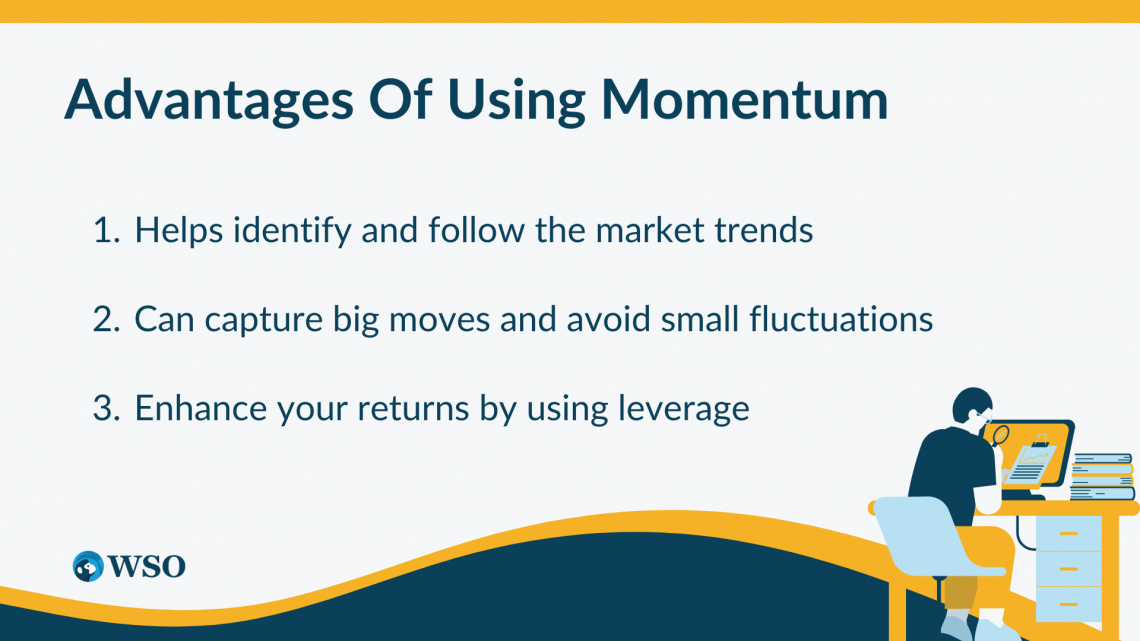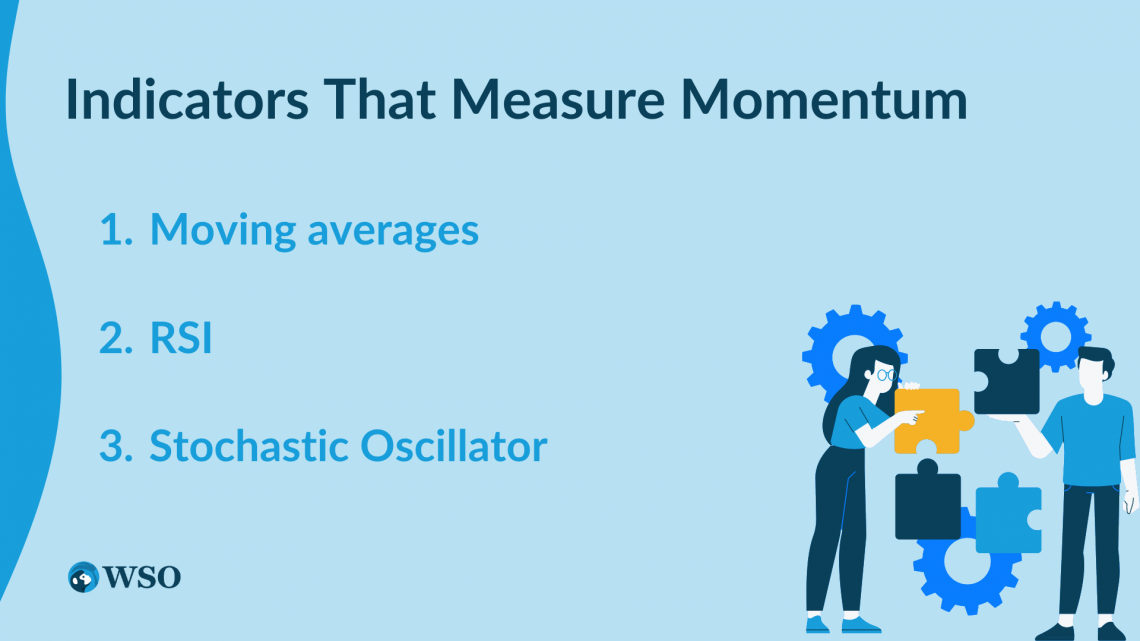Momentum
An asset's recent trend can influence its price movement tendency, hence the term momentum.
Moving things in one direction is more likely to keep moving that way, which is basically what momentum is. This can apply to stock prices, which typically continue to rise or drop

The concept is rooted in the belief that market trends tend to endure, which can be profitable for investors who go along with them.
Throughout time, it has been quite obvious. Market and investment areas have proven that it is not a new occurrence. This phenomenon has been known for most of recent history. They discovered that stocks that have succeeded in the past tend to surpass those that have not.
This particular event has now been noted in several locations around the globe, varying from equities to bonds and even cryptocurrencies. Should the market be efficient and always reflect all of the available information? Not always.
Factors such as herd mentality, emotions, overconfidence, biases, etc., often influence investor behavior, leading to price trends that deviate from the fundamental value of the assets.

There are various hypotheses to account for this occurrence. The irrational decision-making of investors remains one of the most widely accepted ones. Incorporating this occurrence into your investing plan is feasible in various ways.
An approach that has garnered favor is known as momentum trading, which involves procuring ascending assets while selling declining ones with the expectation that the trends will proceed.
Those who trade this way employ technical indicators like oscillators, trend lines, moving averages, and others to determine the force and course of price fluctuations.
Volatility, reversals, and transaction costs are all risks inherent in this trading practice that, if executed correctly, can yield profit. Asset prices are affected by various factors, and this interesting concept helps to understand how markets work. It can also provide benefits to those who utilize it.
Key Takeaways
- An asset's recent trend can influence its price movement tendency, hence the term momentum.
- Investors seek to profit by buying assets that have been increasing in value. Meanwhile, they relinquish assets that have decreased in value over time.
- Indicators like the relative strength index, moving average convergence divergence, or moving averages are among some ways to measure this value.
- There are two types of this value, called relative and absolute momentum.
- While certain tactics may yield success during a trending market, they can also lead to significant losses when the market inevitably takes a turn. The key is to remain vigilant and adaptable, always ready to adjust your approach as needed.
- Market sentiment, herd behavior, investor psychology, and news events all play a role in shaping momentum.
- Although this value can help identify market trends and capture investor sentiment, it can also lead to costly trading mistakes.
Understanding Momentum
Assets in finance—stocks or bonds—have the propensity to remain on the trajectory they've already been traveling. A stock that's been on an upward streak for some time will have a higher chance of keeping such momentum, and the opposite is true.

This idea is founded on the notion that preceding progress will shape future progress and that trends will sustain in the future.
Looking at the returns of an asset over a certain period, commonly six months to a year, is one method to measure this value. This value can be measured in various ways but is strengthened by higher returns.
By comparing an asset's returns with those of a benchmark—such as a market average or index—investors can determine if the asset is underperforming or outperforming the market. This strategy, known as relative momentum, is an effective way to gauge performance.

However, momentum traders face the challenges of false signals and market reversals. In both of these situations, it can give the wrong signal to buy or sell. As a result, it is crucial for these traders to implement risk management.
Investors hoping to capitalize on price movements often use this trading strategy. They buy assets with buoyant trends and sell assets that are showing negative trends. The end goal for these traders is to ride price trends and cash out before it comes crashing down.
How To Calculate Momentum
Identifying assets that will keep moving in the same direction and those that will either reverse or slow down can be assisted with this value. There are various methods to calculate this value. One of the most frequently utilized techniques is the rate-of-change formula.

To determine this value, this formula evaluates the value of an asset at a specified interval in the past and compares it to the current price. Multiplying this difference by 100 yields this value. Let's examine a stock currently priced at $15.
Say it was valued at $10 five days ago. To calculate its 5-day momentum, we would need to:
Momentum = (Current Price / Price N Days Ago) x 100 = (15 / 10) x 100 = 150
The price increase of 50% in the last five days has given the stock a positive value of 150. A positive value indicates a rising price. Meanwhile, a falling price is indicated by a negative value.
The line's smoothness can be augmented by varying the time used to compute its value. These different periods can range from 10 days to much longer. It is worth noting, however, that increasing the period's duration will dull the line's responsiveness to recent price changes.
Note
Fluctuations and noise may be more frequent in highly sensitive lines that are designed to operate over shorter times.
Some traders use a certain value to detect entry and exit opportunities in trading. When this value crosses above zero, it can be viewed as a signal to buy. Meanwhile, it can indicate a time to sell when it descends below zero.
This helps traders make moves according to this value, buying when prices increase and selling when prices decrease. This tactic is often referred to as momentum trading.
An indicator's imperfection is one of its limitations. It can frequently diverge from the price trend, exhibiting a different direction than the actual price movement. This occurrence indicates a weakening or potential reversal of the trend.
Note
On occasion, it can linger at extreme levels for extended periods. In this situation, it signals the overbought or oversold condition of an asset. This can either indicate a potential correction or a continuation of the trend.
By using various indicators and tools like trend lines, moving averages, support and resistance levels, volume, and more, we can get a fuller understanding of the market situation and enhance our trading decisions.
It is crucial to utilize this value alongside other sources of information.
Momentum And The Efficient Market Hypothesis
While this technique can be profitable, it also entails certain risks like market crashes, unpredictability, and reversals.

Asset prices are believed to reflect all available information as per the efficient market hypothesis. However, an interesting phenomenon challenges this theory as past performance seems to affect future performance.
The efficient market hypothesis comes in three forms. The weak form argues that any technical data is always factored into the market price. The semi-strong form claims that only insider information is not factored into the market price.
Meanwhile, the strong form argues that the market is always perfectly efficient and that there is no possibility of beating the market. Momentum challenges the efficient market hypothesis because it shows that past data can influence future prices.

This suggests that trends do exist even though the theory doesn't permit it. The efficient market hypothesis argues that the market is always one step ahead. Any new information is automatically incorporated into stock prices and bond prices.
This means that there is no way to exploit the market because all the knowledge is instantly held by everyone as soon as it is available.
Absolute Vs Relative Momentum
The two main types are absolute and relative momentum. Both types are useful to investors, but they differ in some crucial aspects.

Learning about their differences can help you identify the best one for your strategy.
1. Absolute
It looks at an asset's performance over time. Over a certain time frame, often 12 months, the price of an asset is measured against its past price to determine its current value.
The asset's absolute value is positive when the current price surpasses the previous price. The asset's absolute value is negative if the current price is lower than past prices.
The absolute value tells us if an asset is in an uptrend or a downtrend. It can help us avoid investing in assets that are losing value and switch to safer assets like cash or bonds when the market is falling.
Note
The absolute version of the value can also reduce the risk of large losses or drawdowns during bear markets.
2. Relative
It compares the performance of an asset to that of its peers. It ranks different assets or asset classes based on their returns over a certain period, like 12 months. The assets with the highest returns have a positive relative value.
The assets with the lowest returns have a negative relative value. The relative value tells us which assets are outperforming or underperforming others. It can help us invest in assets that are leading the market and avoid assets that are lagging.
Note
The relative value can also increase the returns of a portfolio by capturing the best opportunities across different markets.
Both types of this value have been shown to work well in finance. They can improve the risk-adjusted returns of a portfolio compared to buy-and-hold strategies. They can also be combined to create a dual momentum strategy that benefits from both forms.
Advantages And Disadvantages Of Using Momentum
Traders try to exploit this phenomenon by buying assets that are going up and selling assets that are going down. You can use this strategy in your portfolio by using the Relative Strength Index, a more commonly used momentum indicator.

When this index reaches over 70, it may be a good time to sell because it shows that the momentum is slowing. Meanwhile, a RSI below 30 can signal buying because it shows positive momentum.
There are some advantages and disadvantages of using this value in finance.
Let's start with the advantages:
1. Helps identify and follow the market trends
This strategy can be lucrative over time because of the broader trends it identifies. By aligning your trades with the dominant direction of the market, you can reduce the risk of going against the crowd and losing money.
2. Can capture big moves and avoid small fluctuations
By focusing on assets that have strong and consistent momentum, you can filter out the noise and volatility of the market and benefit from large price changes.
3. Enhance your returns by using leverage
Leverage is the use of borrowed money to increase your exposure to an asset. Using leverage, you can amplify your gains (and losses) from this form of trading. For example, if you buy a stock with a ten percent margin, you only put up ten percent of the value of the stock.
In this case, you can effectively control ten times more shares than you could with your own money. You will double your money if the stock goes up by ten percent.
However, it also has some disadvantages:

1. Risky and unpredictable
This type of trading assumes that past performance will continue in the future. This is not always true. Sometimes, it can reverse suddenly and unexpectedly, causing large losses for traders who are caught on the wrong side of the market.
For example, consider a stock that has been going up for a long time. Imagine if it suddenly drops due to bad news or profit-taking. Those traders who bought the stock may face a big loss.
2. Can also be affected by external factors
For example, market sentiment, news events, economic data, political developments, etc., can all influence the direction and strength of this value. These factors can create opportunities or challenges for these traders, depending on how they react to them.
However, changes in market dynamics can have significant effects on pre-existing price trends.
Note
Market inefficiencies can distort the market price of the stock to the point that it no longer reflects the fair value of the company.
3. Can also lead to overconfidence and emotional trading
This type of trading can generate quick and easy profits. This can also make traders overconfident. This can lead to taking excessive risks, ignoring warning signs, chasing losses, or holding on to losing positions for too long.
On the other hand, this type of trading can also make traders fearful and anxious when they face losses or uncertainty. This can lead to panic selling, cutting profits short, or missing out on opportunities.
Note
You should have a clear trading plan that defines your entry and exit points, your risk-reward ratio, your position size, your stop-loss and take-profit levels, etc. You should also monitor the market conditions and adjust your strategy accordingly.
You should always keep your emotions in check and follow your rules. In addition, stop-loss orders can ensure that your emotions do not play a role in your decision-making. Setting a risk-reward ratio can also help you make rational decisions under stress.
Applying diversification and position sizing can ensure that your losses from this strategy are limited.
Indicators That Measure Momentum
These indicators are tools that help identify and quantify the strength of a trend and spot potential reversals or corrections. You can use these tools to create your strategy through backtesting.

For example, you can set rules to purchase a stock when the closing price crosses above a 12-month moving average and to sell the stock when the price crosses below the moving average.
Note
Using this form of backtesting can help you evaluate the performance of your trading strategy before you put it into practice.
But among the various indicators available, three are widely used: moving averages, stochastic oscillators, and relative strength index (RSI). Let’s examine how each one works and how to use it in your trading strategy.
1. Moving averages
Over a specific time, average pricing for an asset is displayed through indicators that are both simple and potent. They smooth out the price fluctuations and reveal the underlying trend.
Price movement direction and speed are shown by various types of moving averages such as simple, exponential, or weighted. Nevertheless, they all have a common objective. You can use one or more moving averages on your chart, depending on your time frame and preference.
When you're dealing with moving averages, one popular technique is to hunt for crossovers - those times when two different moving averages meet up and cross paths. For example, if a shorter-term moving average crosses above a longer-term one, it signals a bullish trend.
Note
It is considered bullish because the momentum is increasing. If it crosses below, it signals a bearish trend because momentum is decreasing.
2. RSI
This is another popular indicator that measures the magnitude and speed of price changes. It is an indicator that reveals whether an asset is overbought or oversold on a scale of 0 to 100.
Overbought means that the price has risen too much and too fast and may be due for a pullback. Oversold means that the price has fallen too much and too fast and may be due for a bounce.
Generally, RSI values above 70 indicate overbought conditions, while values below 30 indicate oversold conditions. You can use RSI to confirm trends, spot divergences, or identify entry and exit points.
Note
RSI also signals momentum because changes between overbought and oversold can signal changes in the rate at which the stock price is changing.
3. Stochastic Oscillator
This is another indicator that compares the closing price of an asset to its price range over a certain period. It also ranges from 0 to 100, showing whether an asset is overbought or oversold.
However, unlike RSI, a stochastic oscillator has two lines: %K and %D. %K is the main line that shows the current position of the price relative to its range. %D is a smoothed version of %K that acts as a signal line.
You can use a stochastic oscillator to look for crossovers, divergences, or extreme values.




or Want to Sign up with your social account?